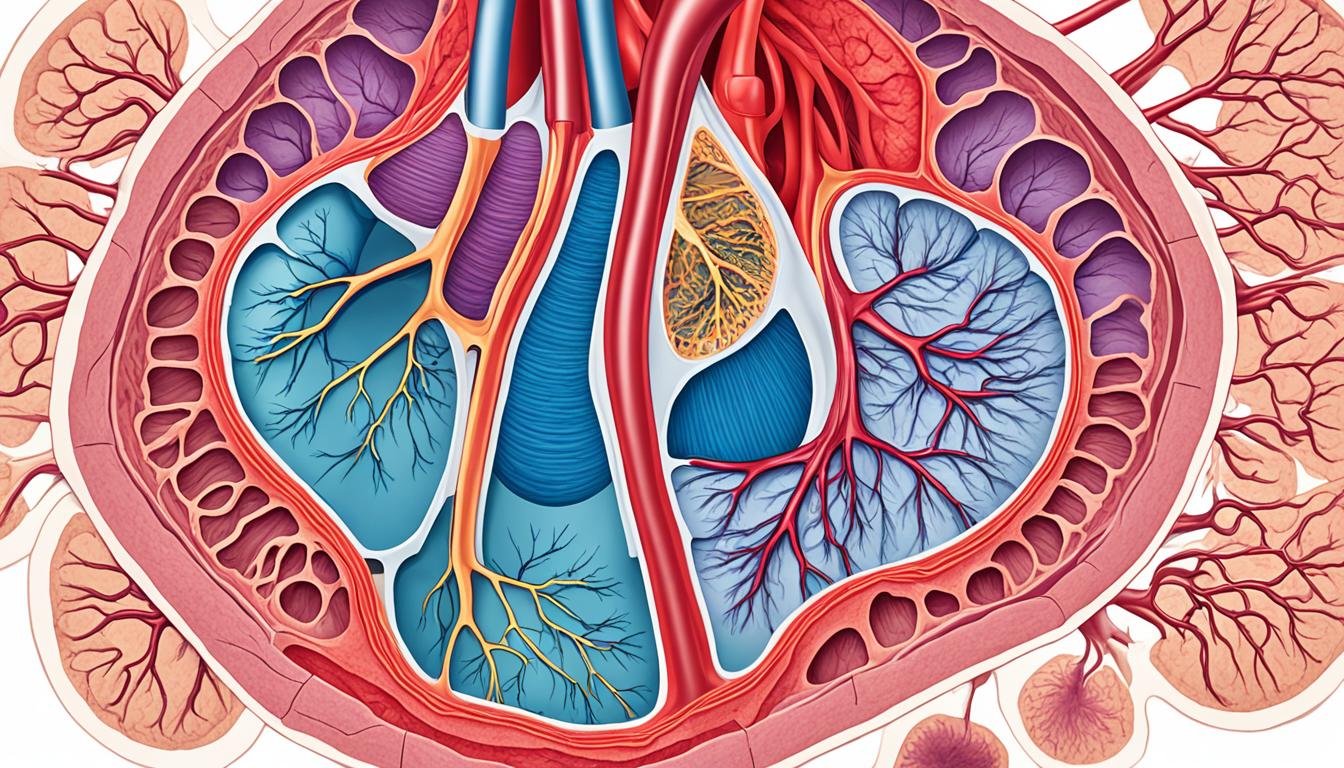Pulmonary valve stenosis makes the valve between the lower right heart chamber and lung arteries narrow. This narrowing reduces blood flow through the valve. The issue can be mild or severe, with some people not feeling anything. But, symptoms might include feeling tired, finding it hard to breathe, having chest pain, fainting, or looking blue in babies. It’s usually due to a heart problem present at birth.
But, some adults might get it from other diseases. Quick diagnosis and treatment matter a lot. Treatments can involve using drugs, fixing the valve with a balloon, or surgery to swap out the valve. And, there’s a promising treatment using stem cells for those born with heart problems.
Key Takeaways:
- Pulmonary valve stenosis makes the valve between chambers and lungs narrow, which lessens blood flow.
- Its symptoms vary from mild to severe and may include things like heart murmurs and feeling exhausted.
- This issue often happens from birth but can also develop from other illnesses later in life.
- It’s crucial to get diagnosed and treated quickly to avoid complications.
- Treatments range from medicines to surgery, with newer options like stem cell therapy becoming available.
The image here just shows examples and may not directly link to what causes pulmonary valve stenosis.
What is Pulmonary Valve Stenosis?
Pulmonary valve stenosis is a heart condition. It features a narrow pulmonary valve. This valve helps blood flow from the heart to the lungs. It is present from birth and limits blood flow due to valve issues.
People with this condition might have a heart murmur. They could also feel tired, struggle to breathe, or feel chest pain. Infants may even have a bluish tint to their skin if their breathing is not right. How bad the symptoms are depends on how narrow the valve is.
Doctors check for pulmonary valve stenosis with a physical exam and tests. These tests may include an ECG, echocardiogram, and cardiac catheterization. It’s important to find out early to prevent problems and help people with this condition live well.
The treatment for this condition varies. Mild cases might not need any treatment. But severe cases might require surgery or other procedures to fix or change the valve.
Stem cell therapy and tissue engineering are being studied for this condition. These new methods might mean we can fix the heart for the long term. This could be a big step forward from surgery.
In short, pulmonary valve stenosis is a heart problem that limits blood flow. Early detection and proper care are critical to help with symptoms and avoid complications. Research in stem cells gives hope for better ways to help people with this condition.
Causes and Risk Factors of Pulmonary Valve Stenosis
Pulmonary valve stenosis is a heart condition you’re born with. Doctors call this a congenital heart defect. While the exact cause isn’t clear, it likely happens when the pulmonary valve doesn’t form right in the womb. Sometimes, the valve’s cusps are thick or stuck together. This makes the valve not open fully. As a result, there’s less room for blood to leave the heart’s lower right chamber. This causes pressure on the heart.
Some factors that make you more likely to have pulmonary valve stenosis are:
- Getting German measles while the mother is pregnant
- Having Noonan syndrome, which affects the heart and other parts of the body
- Once having rheumatic fever, which can harm the heart’s valves
- Dealing with carcinoid syndrome, a cancer that emits chemicals into the blood
Pulmonary valve stenosis can cause several health problems, such as:
- Infections around the heart
- Heartbeats out of rhythm
- Heart muscle getting too thick
- Failing heart
- Issues during pregnancy
Getting diagnosed and treated for this condition early is key. It helps to avoid more severe health issues.
Risk Factors for Pulmonary Valve Stenosis
| Risk Factors | Description |
|---|---|
| Congenital Heart Defects | Heart issues formed before birth |
| Exposure to German Measles | Infection during pregnancy |
| Noonan Syndrome | Genetic sickness that affects the heart and other parts |
| History of Rheumatic Fever | Disease from before that can damage heart valves |
| Carcinoid Syndrome | Uncommon cancer that releases harmful substances into the blood |
Knowing about the causes and risks of pulmonary valve stenosis is critical. It lets both people and their doctors work together to prevent and treat it better.
The Potential of Stem Cell Therapy for Pulmonary Valve Stenosis
Stem cell therapy has made great strides in treating congenital heart defects like pulmonary valve stenosis. It involves creating living material from cells that can be added to the heart. This method allows the organ to heal and function better over time, offering a longer-lasting fix than surgeries.
Scientists are looking at different stem cell types, like heart and vessel stem cells, to repair damaged hearts. They are finding which cells work best to help build new heart muscle.
Adding stem cells to current heart surgeries could meet the needs of patients with valve stenosis. But, we still need to learn more about how safe and effective this approach is through more studies and tests.

